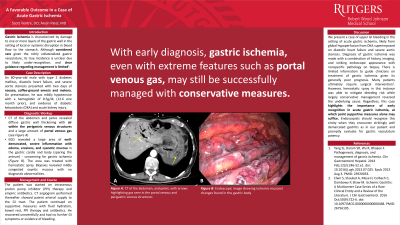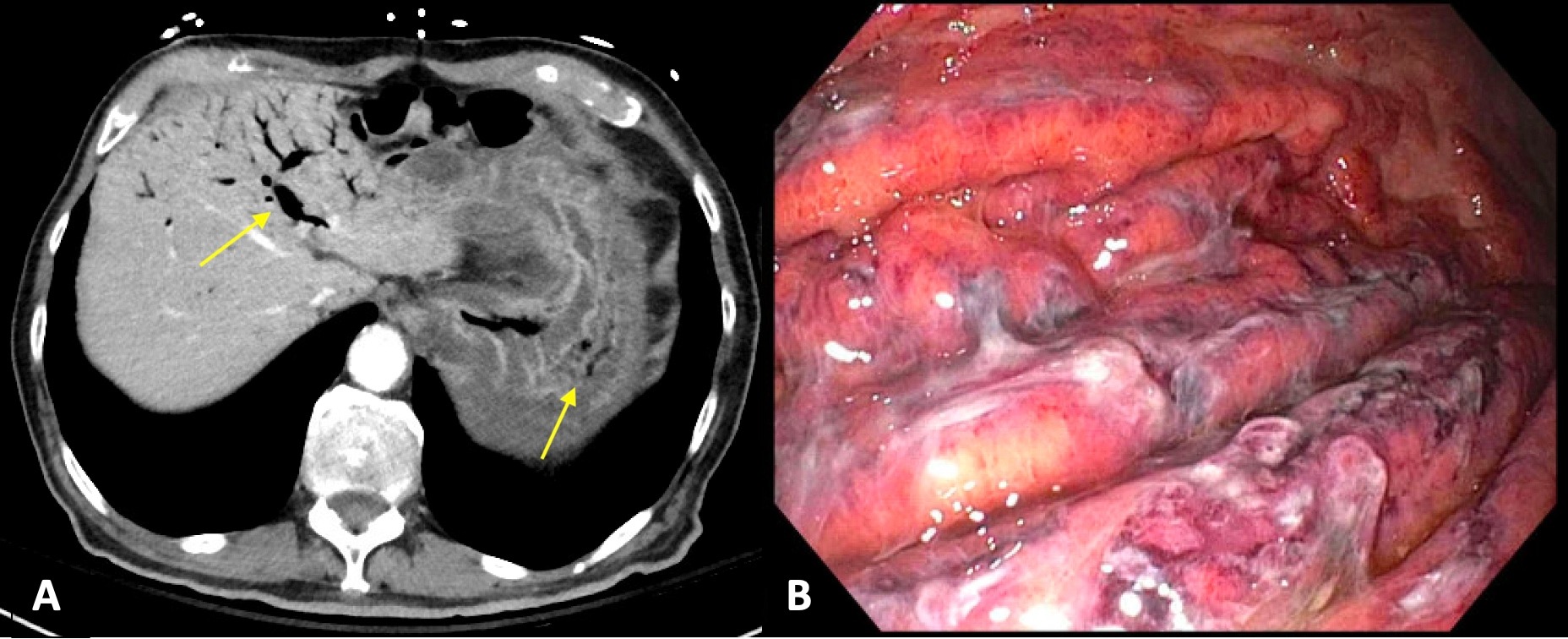Monday Poster Session
Category: Stomach
P2801 - A Favorable Outcome in a Case of Acute Gastric Ischemia
Monday, October 23, 2023
10:30 AM - 4:15 PM PT
Location: Exhibit Hall

Has Audio
- SV
Scott Ventre, DO
Robert Wood Johnson University Hospital
New Brunswick, New Jersey
Presenting Author(s)
Scott Ventre, DO1, Anish V. Patel, MD2
1Robert Wood Johnson University Hospital, New Brunswick, NJ; 2Rutgers Robert Wood Johnson Medical School, New Brunswick, NJ
Introduction: Gastric ischemia is characterized by damage to one or more layers of the gastric wall in the setting of local or systemic disruption in blood flow to the stomach. Although considered rare given the richly collateralized gastric vasculature, its true incidence is not well-defined due to likely under-recognition and difficulty in establishing a definitive diagnosis.
Case Description/Methods: An 80-year-old male with type 2 diabetes mellitus, diastolic heart failure and severe aortic stenosis presented with two days of nausea, coffee-ground emesis and melena. On presentation, he was mildly hypotensive with a hemoglobin of 8.5g/dL (12.6 one month prior), and evidence of diabetic ketoacidosis (DKA) and acute kidney injury. Computed tomography (CT) showed diffuse gastric wall thickening with air within the perigastric venous structures and a large amount of portal venous gas (Figure 1A). He was started on intravenous proton pump inhibitor (PPI) and empiric antibiotics. Upper endoscopy revealed a large area of well-demarcated, severe inflammation with edema, erosions, and cyanotic mucosa in the gastric cardia and body (sparing the antrum) - concerning for gastric ischemia (Figure 1B). The area was treated with hemostatic spray. Biopsies revealed mildly congested oxyntic mucosa with no diagnostic abnormalities. CT angiogram thereafter showed patent arterial supply to the GI tract. The patient continued on supportive measures with fluid hydration, bowel rest, PPI therapy and antibiotics. He recovered uneventfully and had no further GI symptoms or evidence of bleeding.
Discussion: We present a case of upper GI bleeding in the setting of acute gastric ischemia, likely from global hypoperfusion from DKA superimposed on diastolic heart failure and severe aortic stenosis. Diagnosis of gastric ischemia was made with a combination of history, imaging, and striking endoscopic appearance with nonspecific pathology on biopsy. There is limited information to guide clinicians on treatment of gastric ischemia given its generally poor prognosis. However, hemostatic spray in this instance was able to mitigate bleeding risk while largely conservative management reversed the underlying cause. Regardless, this case highlights the importance of early recognition in acute gastric ischemia, at which point supportive measures alone may suffice. Endoscopists should recognize this entity when they encounter strikingly well-demarcated gastritis as in our patient and promptly evaluate for gastric vasculature patency.

Disclosures:
Scott Ventre, DO1, Anish V. Patel, MD2. P2801 - A Favorable Outcome in a Case of Acute Gastric Ischemia, ACG 2023 Annual Scientific Meeting Abstracts. Vancouver, BC, Canada: American College of Gastroenterology.
1Robert Wood Johnson University Hospital, New Brunswick, NJ; 2Rutgers Robert Wood Johnson Medical School, New Brunswick, NJ
Introduction: Gastric ischemia is characterized by damage to one or more layers of the gastric wall in the setting of local or systemic disruption in blood flow to the stomach. Although considered rare given the richly collateralized gastric vasculature, its true incidence is not well-defined due to likely under-recognition and difficulty in establishing a definitive diagnosis.
Case Description/Methods: An 80-year-old male with type 2 diabetes mellitus, diastolic heart failure and severe aortic stenosis presented with two days of nausea, coffee-ground emesis and melena. On presentation, he was mildly hypotensive with a hemoglobin of 8.5g/dL (12.6 one month prior), and evidence of diabetic ketoacidosis (DKA) and acute kidney injury. Computed tomography (CT) showed diffuse gastric wall thickening with air within the perigastric venous structures and a large amount of portal venous gas (Figure 1A). He was started on intravenous proton pump inhibitor (PPI) and empiric antibiotics. Upper endoscopy revealed a large area of well-demarcated, severe inflammation with edema, erosions, and cyanotic mucosa in the gastric cardia and body (sparing the antrum) - concerning for gastric ischemia (Figure 1B). The area was treated with hemostatic spray. Biopsies revealed mildly congested oxyntic mucosa with no diagnostic abnormalities. CT angiogram thereafter showed patent arterial supply to the GI tract. The patient continued on supportive measures with fluid hydration, bowel rest, PPI therapy and antibiotics. He recovered uneventfully and had no further GI symptoms or evidence of bleeding.
Discussion: We present a case of upper GI bleeding in the setting of acute gastric ischemia, likely from global hypoperfusion from DKA superimposed on diastolic heart failure and severe aortic stenosis. Diagnosis of gastric ischemia was made with a combination of history, imaging, and striking endoscopic appearance with nonspecific pathology on biopsy. There is limited information to guide clinicians on treatment of gastric ischemia given its generally poor prognosis. However, hemostatic spray in this instance was able to mitigate bleeding risk while largely conservative management reversed the underlying cause. Regardless, this case highlights the importance of early recognition in acute gastric ischemia, at which point supportive measures alone may suffice. Endoscopists should recognize this entity when they encounter strikingly well-demarcated gastritis as in our patient and promptly evaluate for gastric vasculature patency.

Figure: Figure 1
Disclosures:
Scott Ventre indicated no relevant financial relationships.
Anish Patel indicated no relevant financial relationships.
Scott Ventre, DO1, Anish V. Patel, MD2. P2801 - A Favorable Outcome in a Case of Acute Gastric Ischemia, ACG 2023 Annual Scientific Meeting Abstracts. Vancouver, BC, Canada: American College of Gastroenterology.
